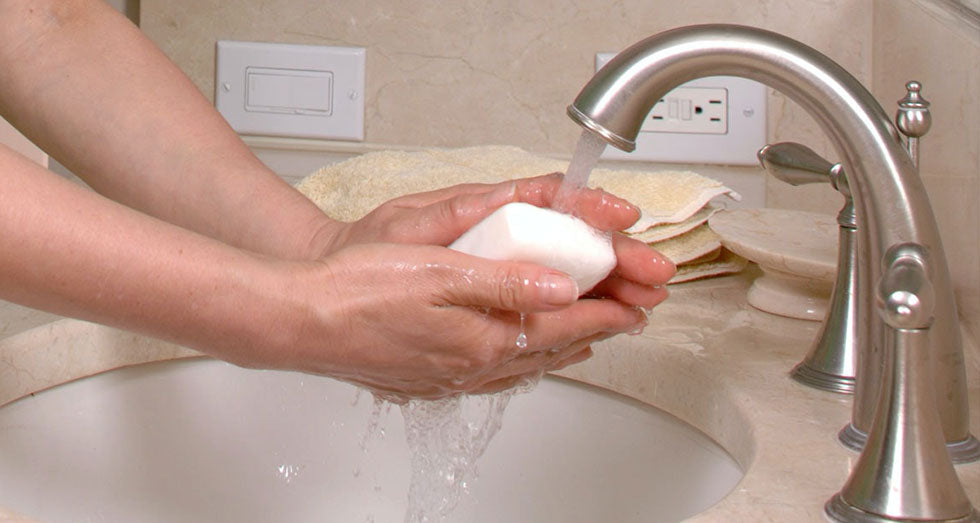To survive an emergency it is important to stay healthy. The best way to maintain health is to keep yourself and your living area clean and sanitary. Poor hygiene and unsanitary conditions can cause sickness.
Sanitation items are easy to gather. You may prefer a preassembled emergency kit which already contains necessary items for grooming and sanitation. Preassembled kits are generally less expensive and are a more convenient way to prepare all that you'll need during an emergency.

Another option may be to assemble your own emergency kit so you can choose the items your family is accustomed to using or specifically desire to have. Often, you can purchase your favorite brand of soap, toothpaste, shampoo, toilet paper, deodorant and other items in bulk or extra saving packages so you can afford to set some aside for your emergency kit.
Essential Gear for Sanitation in Emergency
FACE MASKS
During a pandemic, or even a severe cold and flu season, face masks are an important element of emergency hygiene. For the purposes of spreading respiratory illnesses, standard surgical facemasks or home-made and store bought cloth facemasks work well. Remember to dispose of surgical face masks after a use or two and wash cloth masks after use.

HAND SANITIZER
Washing hands is always your best option for removing the viruses and bacteria that cause illness, but in a pinch, hand sanitizer can work too. Just make sure to apply it liberally and rub your hands for 20 seconds, just like you would washing them. You can purchase hand sanitizer, or make your own.

TOILET PAPER
When it comes to emergencies, any kind of toilet paper--smooth, soft, rough, printed, colored, plain, or scented is a luxury. By preparing ahead of time, you can insure that you don't experience unneeded discomfort by having to get used to a new texture of paper. Also keep in mind that it is common for those in emergency situations to develop stress and diet related stomach problems that can intensify your sanitation difficulties.

TOOTHBRUSH
People with sensitive teeth may want to store their preferred brand of toothbrush in their emergency kit. It is probably a wise idea to store several toothbrushes to give away to someone who neglected to store one. It may also have another useful purpose such as cleaning or scrubbing.

TOOTHPASTE, MOUTHWASH, BREATH FRESHENER
Emergencies present stressful situations where human communication is crucial. Sometimes water is scarce or unavailable which causes dryness in your mouth. A breath freshener may be a nice addition to your preparedness supplies.
FEMININE HYGIENE PRODUCTS
It is important to be prepared in all areas. These items are definitely important to have available in any emergency situation.

DEODERANT
With several choices of deodorants including antiperspirants, made-for-a-woman brands, gelled, etc., you may want to decide ahead of time what you'll need during an emergency. Air fresheners or deodorants may also increase your level of comfort during an emergency.

HAIR SUPPLIES
Shampoo, conditioner, hairspray, combs, brushes, and other items may not be necessary for survival, but they can help make an emergency situation more comfortable and clean. Be sure to store smaller sanitation items in your emergency kit and be aware that you can overstuff your emergency kit. If it is too heavy, you may not be able to leave with it during an emergency.
LAUNDRY DETERGENT AND SOAP
During some emergencies, you may be required to evacuate the area or may be stranded in some remote area. Because you won't have lots of clothing, you will want detergent to clean your clothes and soap for bathing and for washing utensils. Hand sanitizers are also great to have on hand (no pun intended).

MEDICATIONS
For people who take prescription medications for heart disease, diabetes, asthma, depression, or any other condition that requires regular medication, you should talk to your physician about having a back-up supply on hand for emergencies. Medications for diarrhea, constipation, headaches, allergy and other minor conditions should also be included in kits for added comfort.
MAKESHIFT TOILET
With a little preparation, you can have a decent emergency toilet. If you have a medium sized plastic bucket (5-6 gallon), lined with a heavy-duty garbage bag, you have a toilet. Make sure you have a lid to cover it. A plastic toilet seat can be purchased to fit on the bucket for a more comfortable seat. If you don’t have an extra plastic bucket available, you can make a latrine by digging a long trench approximately one foot wide and 12 to 18 inches deep and cover as you go. When you dig too deep a latrine it can retard the bacterial breakdown process. The long latrine approach is appropriate for large groups camping in one spot for a long period.
For those back country hikers, packing out all solid waste is always appropriate, and some authorities at high-use rivers usually require this process.
You can make a seat for your latrine by laying logs across the hole, leaving an area open for you to use. After use, cover the waste with small amounts of dirt to decrease the odor. A covered toilet reduces more of the odor than an open one. Make a toilet cover with wood or a large leaf. If the odor becomes unbearable, fill in the latrine completely with dirt and dig a new one. Build a new seat and burn the old wood that you used for the last toilet.
MOST IMPORTANT SANITATION PRACTICES IN EMERGENCIES
WASHING
You can prevent illness by washing your hands often; before eating, after using the bathroom, after you change a diaper, and any other time you may need to freshen up. Because water is such a precious commodity during an emergency, you should remember to use purified drinking water first for drinking, cooking, washing dishes and then for other purposes. Be organized and choose a designated bathing area. If you wash in a river or stream use biodegradable soap and always be aware of others who may be down stream. With a little soap you can also wash yourself in the rain. Other washing alternatives include moist towelettes, a spray bottle, sanitizing lotions, or a wet washcloth. Be sure to wear shoes to prevent parasitic infections and to protect you from cuts and puncture wounds that can easily become infected.
SANITATION AREA
Choosing the right location for your sanitation needs is as important as staying clean. Your waste place must be located downhill from any usable water source. It should also be a few hundred feet from any river, stream, or lake. It also helps to have your waste place downwind from your living area, and yet not too far from your camp that the distance discourages people from using it.

GETTING RID OF REFUSE
If you cannot dispose of refuse properly you should always bury biodegradable garbage and human waste to avoid the spread of disease by rats and insects. Dig a pit 12 to 18 inches deep and at least 50 feet but preferably 200 plus feet downhill and away from any well, spring, or water supply. Fill the pit with the refuse and cover with dirt.

KEEPING FOOD SANITARY
All food scraps should be either burned or buried in a pit far from your living area to keep bears and other wild animals away from you. Keep all your food covered and off the ground. You may keep your food in a tree, but be sure tree dwelling creatures can’t get into it. Replace all lids on water bottles and other containers immediately after use. Do not wash your dishes in the area where you get your drinking water supply. Instead, wash your dishes away from a stream. Use clean plates or eat out of the original food containers to prevent the spread of germs. Wash and peel all fruits and vegetables before eating. Prepare only as much as will be eaten at each meal.
With a little knowledge and preparation, you can stay clean and healthy, even during an emergency situation.




3 comments
turq76
The best throw away toothbrush is the colgate wisp. It has toothpaste in the middle of the bristles, and the end is a dental pick. This would be a great tool for when TSHTF and you go on a diet of tough game meat and need to get food out between your teeth. Poor hygene can cause physical and mental breakdowns.
Anonymous
You need a supply of disposable utensils, paper plates, bowls, trash bags and cups. Trust me when there is no running water you will be glad you have them!
Allrie
Thank you, I'm just getting into your blog, taking the quiz made me decide I needed a refresher class. And the blog is extremely helpful. I try to use a mixed bag of storage, and need to beef up some areas. I have also discovered that my married children have somehow put off any real food storage…so am trying to get them moving on it! Thank you.